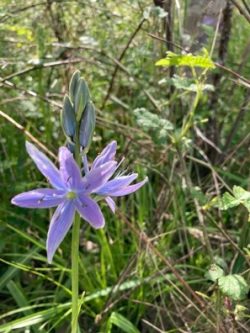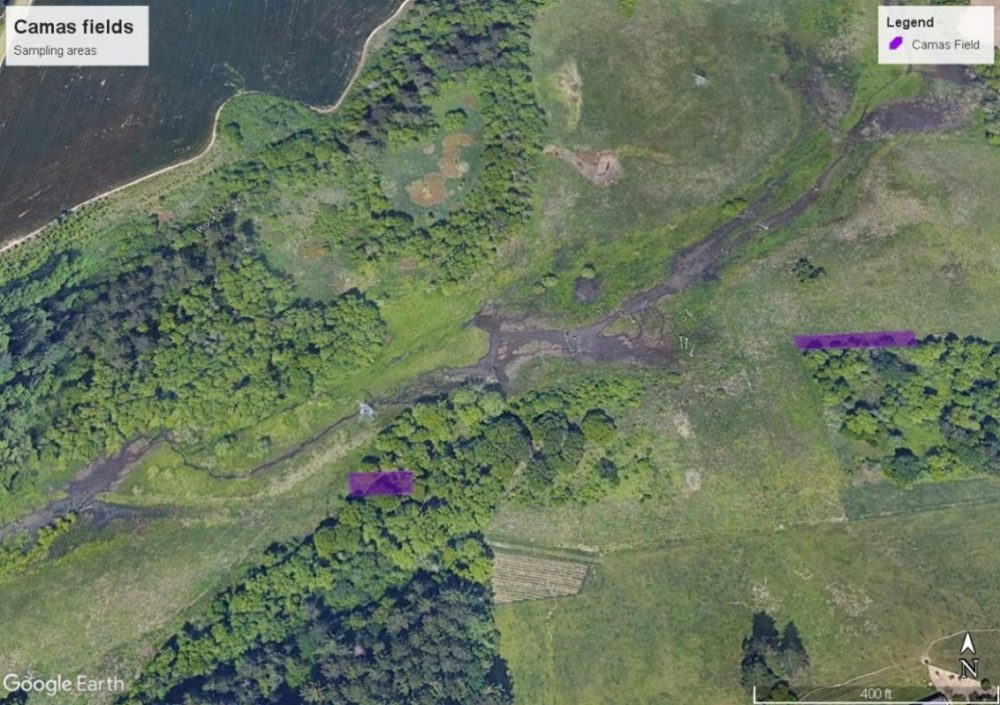Camas study: screening soil and camas bulbs for heavy metals and herbicide residue

Flowering camas
Introduction
Camas is an edible flowering bulb from the same family as asparagus. It has a special significance to many Indigenous people, including the Kalapuya, as a first food. First foods are traditional and culturally significant foods eaten by Indigenous communities. Kalapuyans have lived in the Tualatin Basin since time immemorial, harvesting and roasting camas bulbs from wetland habitats, wet meadows, and oak prairies. These habitats have been historically undervalued under settler colonialism, though they have served integral ecosystem functions for thousands of years. As these ecosystems in the Rock Creek Environmental Studies have been enhanced and restored in recent years, the native camas has begun to bloom and spread.
At the Rock Creek Environmental Studies Center, there are several patches of camas, the largest of which are located in and around the East and West camas fields. We are working with partners to engage Indigenous community members in the tending and harvest of camas using traditional ecological and cultural knowledge. But first, we wanted to make sure that the soil and plants at the site would be safe for human use and consumption. The goal of our study was to determine if the camas bulbs in these locations could be a safe food source, or if the soil or bulbs were contaminated with herbicide residue or heavy metals that could be harmful to humans.
We used the RCRA 8 test to screen for heavy metals that are harmful to human health. We don’t have any reason to think these will be present at elevated levels. The RCRA8 test is used for eight metals in soil including: arsenic, barium, cadmium, chromium, lead, mercury, selenium and silver. This test is named for the Resource Conservation & Recovery Act which aims to prevent hazardous waste contamination. This is a standardized Environmental Protection Agency (EPA) protocol for soil testing at contaminated sites. We also tested for the herbicides that have been used in the Rock Creek floodplain enhancement site in the past several years to manage invasive plants including reed canarygrass, pasture grasses, and blackberry.
To learn more about pesticides, visit the National Pesticide Information Center at Oregon State University.
Methods
We used randomized systematic sampling to ensure that all portions of the camas fields were represented in composite soil samples. This reduces bias and allows us to generalize our results to the entire rectangular area sampled. We used a soil probe to remove a core of soil ~6 inches deep from each of the 50 cells in our rectangular grid area, and placed the soil samples in 5-gallon bucket. This process was repeated for all cells, and then used again for duplicate and triplicate samples – each time with a new random starting location and placed in a different bucket. We collected three composite soil samples from the East camas field and one composite soil sample from the West camas field.

Approximate locations of camas fields are indicated in purple, to the south of the Rock Creek floodplain.
Soil samples were collected from East (triplicate) and West (single) camas fields (top 6” of soil):
- 3 1-gallon jars, each containing a composite sample from the East field
- 1 1-gallon jar for a composite sample from the West field
- 1 Ziplock bag for composite sample from the East field
- 1 Ziplock bag for composite sample from the West field
The following analyses were performed on the soil samples:
- Apex Labs: RCRA8 (EPA test for lead and heavy metals) x 4 samples
- Pacific Agricultural Labs: Herbicide residues
- Soil glyphosate (RoundUp herbicide) x 2 samples
- Soil imazapyr (herbicide used on reed canarygrass) x 2 samples
- Soil triclopyr (herbicide used on blackberry) x 2 samples
Camas bulbs were collected and placed in gallon Ziplock bags:
- 100 grams of wet plant tissue (~ 4 bulbs) from East camas field
- 100 grams of wet plant tissue (~ 4 bulbs) from West camas field
The following analyses were performed on camas plant tissue:
- Glyphosate test: 1 for each field
- Imazapyr test: 1 for each field
- Triclopyr test: 1 for each field



Images: White flags indicate the location of camas plants near East camas field, camas plant in the hands of a student, and students sampling soil in West camas field.
Results
Results from heavy metal testing of the soil in the East and West camas fields show that amounts of arsenic and chromium are present in quantities much lower than those considered to be toxic to humans. The levels of barium and lead are lower than the concentrations that naturally occur in soil found in the Portland basin, and are lower than levels considered to be toxic. Other heavy metals that are toxic to humans – cadmium, mercury, selenium, and silver – and that are typically found in small amounts in the soil of our region were not detected at all in the soil collected from the camas fields.

RCRA metal levels in RCESC camas fields in comparison to background and screening levels.ND means ‘Not detected’
In addition, herbicide residue was not detected in either the soil or the camas bulbs. This means that enough time has passed since herbicides were used in the camas fields, that handling, or eating, the camas bulbs would not pose a health risk. Herbicide residue levels in soil and plants could change if herbicides are used again in the future to help control invasive grasses. We are working with our partners to phase out the use of herbicides in these locations by using other approaches to invasive species management.

Discussion
Low to undetectable levels of heavy metals and herbicide residues were found in the soils and camas bulbs at this site – this is good news! Our next steps include developing a stewardship plan to address invasive plants without using herbicides and strengthening our relationships with the Indigenous community through outreach, relationship building, and by hosting community and school groups in the Rock Creek Environmental Center. If you have questions about this study or would like to get in touch, please email valance.brenneis@pcc.edu.
To learn more, check out this StoryMap created by ESR 204 and GEO 244 student R Huey: Camas on Campus: Testing for harmful pollutants in soils and edible plants.

Acknowledgments
This work was funded by a $5,000 Tualatin Watershed Improvement Grant from the Tualatin Soil and Water Conservation District. The grant proposal was drafted by Fall 2021 ESR 202 students and the work was performed by Spring 2022 ESR 204 students in collaboration with Dr. Val Brenneis. The following students contributed their writing, field work, mapping, and analysis skills to this project: M. Smith, R. Krige, M. Moseley, L. Liebeseller, J. Swanson, S. Nadell, E. Sinclair, E. Comfort, M. Mattson, T. Hull, T. Gniazdowski, S. Carillo, A. Mele, E. Kondilis, D. Cantor, J. Price, L. Hogan, R. Huey, S. Iem, and K. Van Rossum. Dr. David Lewis shared his knowledge of camas, seasonal rounds of the Kalapuya people, and the impacts of settler colonialism on people and ecosystems of the Willamette Valley. Partners including staff from the Five Oaks Museum, Friends of Tryon Creek, Tualatin Hills Parks and Recreation District, Oregon State University, as well as PCC and TSWCD, have helped shape this work and supported our grant proposal. Thank you.

